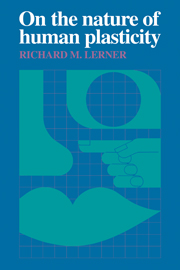Book contents
- Frontmatter
- Contents
- Foreword by Paul Baltes
- Preface
- 1 Perspectives on plasticity
- 2 The life-span view of human development: philosophical, historical, and substantive bases
- 3 Gene marking, recombinant DNA technology, and gene transfer: toward true gene therapy
- 4 Neuroanatomical bases of human plasticity
- 5 Human neurochemistry and the role of neurotransmitters
- 6 Evolutionary biology and hominid evolution
- 7 Comparative-developmental psychological bases of plasticity
- 8 Individual and group interdependencies
- 9 Toward future multidisciplinary efforts
- 10 Conclusions: On the limits of plasticity and the plasticity of limits
- References
- Author index
- Subject index
4 - Neuroanatomical bases of human plasticity
Published online by Cambridge University Press: 22 March 2010
- Frontmatter
- Contents
- Foreword by Paul Baltes
- Preface
- 1 Perspectives on plasticity
- 2 The life-span view of human development: philosophical, historical, and substantive bases
- 3 Gene marking, recombinant DNA technology, and gene transfer: toward true gene therapy
- 4 Neuroanatomical bases of human plasticity
- 5 Human neurochemistry and the role of neurotransmitters
- 6 Evolutionary biology and hominid evolution
- 7 Comparative-developmental psychological bases of plasticity
- 8 Individual and group interdependencies
- 9 Toward future multidisciplinary efforts
- 10 Conclusions: On the limits of plasticity and the plasticity of limits
- References
- Author index
- Subject index
Summary
Consideration of the anatomical characteristics of the human brain provides strong support for the plasticity of human developmental processes. As noted in Chapter 1, and as will be discussed in greater detail in a later chapter, data derived from evolutionary biology and comparative psychology indicate that animals differ in the eventual level of behavioral flexibility attained across their ontogeny. These species differences in behavior are related to corresponding species differences in the ratio of association to sensory fibers in the brain that Hebb (1949) terms the A/S ratio. As Thompson (1981) observes, “moving from more primitive to more complex mammals, following the general course of evolution, the amount of cortex relative to the total amount of brain tissue increases in fairly regular proportions” (p. 7); and although “the basic organization of the cortical sensory and motor areas does not appear to differ markedly from rat to human, … as one ascends the mammalian scale of evolution, the relative amount of association cortex (cortex that is neither sensory nor motor and is concerned with higher or more complex behavioral functions) increases strikingly” (p. 8). Moreover, the primates, and particularly Homo sapiens, exhibit “enormous and disproportionate increases in the amount of cerebral cortex” (Thompson, 1981). And among mammals, humans, although they do not have the largest brain masses, exhibit the highest A/S ratio – indeed “the majority of neurons in the human brain are in the cerebral cortex” (Thompson, 1981).
- Type
- Chapter
- Information
- On the Nature of Human Plasticity , pp. 44 - 65Publisher: Cambridge University PressPrint publication year: 1984
- 1
- Cited by



